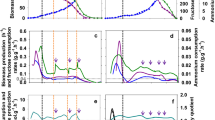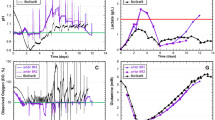Abstract
Optimal feed rate strategy is studied for fed-batch culture of recombinant cells with plasmid instability and with different death rates for the plasmid-free cells (PFC) and plasmid-bearing cells (PBC). Most of the fed-batch fermentation is known to have first-order singularity and therefore a single singular arc. However, this study shows that a singular arc with second-order singularity and therefore two distinct singular arcs are possible for a recombinant cell process if PFC and PBC are subjected to death, and their specific growth rates are proportional to each other. Two types of singular arcs are elucidated and analyzed. The optimal policies over the singular arcs are theoretically explored as these findings reveal qualitative information on the singular arc, which is critically important in providing the optimal initial conditions in numerical computation of optimal feed rate profile.







Similar content being viewed by others
Abbreviations
- F :
-
Feed rate (cm3/s)
- F max :
-
Maximum feed rate (cm3/s)
- F min :
-
Minimum feed rate (cm3/s)
- F singular :
-
Singular feed rate (cm3/s)
- H :
-
Hamiltonian function
- PBC:
-
Plasmid-bearing cells (g)
- PFC:
-
Plasmid-free cells (g)
- k d :
-
Constant death rate (s)
- S :
-
Substrate concentration (g/cm3)
- S F :
-
Feed substrate concentration (g/cm3)
- t :
-
Time (s)
- t f :
-
Final time (s)
- V :
-
Bioreactor volume (cm3)
- V max :
-
Maximum bioreactor volume (cm3)
- x 1 :
-
Total plasmid-containing cells (g)
- x 2 :
-
Total plasmid-free cells (g)
- x 3 :
-
Total substrate (g)
- x 4 :
-
Bioreactor volume (cm3)
- x 5 :
-
Time (t)
- X :
-
Cell mass concentration (g/cm3)
- Y x/s :
-
Cell mass yield (g/g)
- ϕ:
-
Switching function
- μ:
-
Specific growth rate (s)
- α:
-
Fraction of plasmid-containing cells that revert
- β:
-
The ratio, μ−(S) = βμ+(S)
- η:
-
λ4(t f ) = η is a unknown adjoint variable corresponding to x 4(t f ) = V max
- +:
-
Plasmid-bearing cells, PBC
- −:
-
Plasmid-free cells, PFC
References
Altınta MM, Ülgen KÖ, Kırdar ZB, Önsan I, Oliver GS (2003) Optimal substrate feeding policy for fed-batch cultures of S. cerevisiae expressing bifunctional fusion protein displaying amylolytic activities. Enzyme Microb Technol 33:262–269
Anderson TF, Lustbader E (1975) Inheritability of plasmids and population dynamics of cultured cells. Proc Natl Acad Sci USA 72:4085–4089
Bravo S, Mahn A, Shene C (2000) Effect of feeding strategy on Zymomonas mobilis CP4 fed-batch fermentations and mathematical modeling of the system. Appl Microbiol Biotechnol 54:487–493
Bryson AE, Ho YC (1975) Applied optimal control. Wiley, New York
Cheng C, Huang YL, Yang ST (1997) A novel feeding strategy for enhanced plasmid stability and protein production in recombinant yeast fed-batch fermentation. Biotechnol Bioeng 56:23–31
Eugene RA, Sathish Kumar HS, Umesh Kumar S, Misra MC, Ghildyal NP, Karanth NG (2002) High-cell-density fermentation of recombinant Saccharomyces cerevisiae using glycerol. Biotechnol Prog 18:1130–1132
Gupta JC, Pandey G, Mukherjee KJ (2001) Two-stage cultivation of recombinant Saccharomyces cerevisiae to enhance plasmid stability under non-selective conditions: experimental study and modeling. Enzyme Microb Technol 28:89–99
Hardjito L, Greenfield PF, Lee PL (1993) Recombinant protein production via fed-batch culture of the yeast Saccharomyces cerevisiae. Enzyme Microb Technol 15:120–126
Hempel C, Erb RW, Deckwer WD, Hecht DV (1998) Plasmid stability of recombinant Pseudomonas sp. B13 FR1 pFRC20p in continuous culture. Biotechnol Bioeng 57:62–70
Imanaka T, Aiba S (1981) A perspective on the application of genetic engineering: stability of recombinant plasmid. Ann NY Acad Sci 369: 1–14
Kelley HJ (1965) A transformation approach to singular subarcs in optimal trajectory and control problems. SIAM J Control Optim 2:234–241
Khatri NK, Hoffmann F (2006) Impact of methanol concentration on secreted protein production in oxygen-limited cultures of recombinant Pichia pastoris. Biotechnol Bioeng 93:871–879
Kumar PKR, Maschke HE, Friehs K, Schegurl K (1991) Strategies for improving plasmid stability in genetically modified bacteria in bioreactors. TIBTECH 9:279–284
Lin C-S, Lim HC (1992) Utilization of dynamic responses of recombinant cells to improve CSTBR operations. Chem Eng Commun 118:265–278
Lin YH, Hsiao HC, Chou CP (2002) Strain improvement to enhance the production of recombinant penicillin acylase in high-cell-density Escherichia coli cultures. Biotechnol Prog 18:1458–1461
Looser V, Hammes F, Keller M, Berney M, Kovar K, Egli T (2005) Flow-cytometric detection of changes in the physiological state of E. coli expressing a heterologous membrane protein during carbon-limited fedbatch cultivation. Biotechnol Bioeng 92:69–78
Meacock PA, Cohen SN (1980) Partitioning of bacterial plasmids during cell division: a cis-acting locus that accomplishes stable plasmid inheritance. Cell 20:529–542
Oh G, Moo-Young M, Chisti TY (1998) Automated fed-batch culture of recombinant Saccharomyces cerevisiae based on on-line monitored maximum substrate uptake rate. Biochem Eng J 1:211–217
Patnaik PR (2000) Optimizing initial copy number distribution for improved protein activity in a recombinant fermentation. Biochem Eng J 5:101–107
Pontryagin LS, Boltyanskii VG, Gamkrelidze RV, Mishchenko EF (1962) The mathematical theory of optimal processes. Interscience, New York.
Shi XM, Jiang Y, Chen F (2002) High-yield production of lutein by the green microalga Chlorella protothecoidesin heterotrophic fed-batch culture. Biotechnol Prog 18:723–727
Shin HS, Lim HC (2006) Degrees of freedom approach to admissible feed-rate profiles for optimal fed-batch fermentation. Ind Eng Chem Res 45:6227–6235
Skolpap W, Scharer JM, Douglas PL, Moo-Young M (2004) Fed-batch optimization of α-amylase and protease-producing Bacillus subtilis using Markov chain methods. Biotechnol Bioeng 86:706–717
Sussmann HJ (1987) The structure of time-optimal trajectories for single-input systems in the plane: the general real analytic case. SIAM J Control Optim 25:868–904
Wang FS, Cheng WM (1999) Simultaneous optimization of feeding rate and operation parameters for fed-batch fermentation processes. Biotechnol Prog 15:949–952
Xu P, Thomas A, Gilson CD (1996) Combined use of three methods for high concentration ethanol production by Saccharomyces cerevisiae. Biotechnol Lett 18:1439–1440
Xu J, Shpak E, Gu T, Moo-Young M, Kieliszewski M (2005) Production of recombinant plant gum with tobacco cell culture in bioreactor and gum characterization. Biotechnol Bioeng 90:578–588
Yee L, Blanch HW (1992) Recombinant protein expression in high cell density fed-batch cultures of Escherichia coli. Biotechnology 10:1550–1556
Zhang X, Xia Z, Zhao B, Cen P (2002) Enhancement of plasmid stability and protein productivity using multi-pulse, fed-batch culture of recombinant Saccharomyces cerevisiae. Biotechnol Lett 24:995–998
Zhang Y, Taiming L, Liu J (2003) Low temperature and glucose enhanced T7 RNA polymerase-based plasmid stability for increasing expression of glucagon-like peptide-2 in Escherichia coli. Protein Expr Purif 29:132–139
Zund P, Lebek G (1980) Generation time-prolonging R plasmids: correlation between increases in the generation time of Escherichia coli caused by R plasmids and their molecular size. Plasmid 3:65–69
Acknowledgment
One (HSS) of the authors was supported in part by a fellowship from Korea Science and Engineering Foundation (KOSEF) and a grant from the University of California, Irvine.
Author information
Authors and Affiliations
Corresponding author
Appendices
Appendix 1
Re-writing the first ODE of Eq. (6),
where m = −(1−α)μ+ and \(n=-(\lambda_2 \alpha -{\lambda_3} \mathord{\left/ {\vphantom {{\lambda_3} {Y_{x/s}^-}}} \right.}{Y_{x/s}^-})\mu^+.\) On the singular arc m is always negative since α < 1 and μ+ > 0. If n = 0, λ1(t) approaches zero asymptotically. However, n is always negative over the same region because λ2 > 0 and λ3 < 0. This means λ1(t) is less than the negative value of λ1(t) when n = 0 for all times over the singular arc. Therefore, we can say that λ1(t) is always negative over a singular arc. Correspondingly, B is always positive over the singular arc.
Appendix 2
Equation (6) gives rise to the final adjoint variable vector, [−1, 0, 0, η, 0] and the Hamiltonian at the final time is −μ+ x 1(t f). Therefore, the Hamiltonian is negative constant over all time because it must be constant. Over the singular arc where ϕ = 0 and since λ5(t) = 0, we conclude that
Since λ2 is positive over the singular arc, λ2 k d x 2 > 0 and the sufficient condition for Eq. (A2) is
Substituting Eq. (9) into Eq. (A3) and recalling that B is positive over the singular arc, we obtain
Before going through a further analysis of the singular arc, let us restrict the form of specific growth rates μ+ and μ−. As stated in the Introduction, the process uses the difference in death rates of the PBC and PFC. At very low substrate concentrations the PFC suffer death whereas the PBC do not. At low substrate concentrations, no inhibition takes place, and both specific growth rates μ+and μ− increase with the substrate concentration so that both μ + s and μ − s are positive over the affected ranges (very low substrate concentration). Then, \(sign({\mu^+} \mathord{\left/ {\vphantom {{\mu^+} {\mu^-)_s}}} \right. } {\mu^-)_s}\) is negative from Eq. (A4) because sign (μ + s ) is positive. This means that if substrate concentration increases with time \((\dot{S} > 0),\mu^+\) increases and \({\mu^+} \mathord{\left/ {\vphantom {{\mu^+} {\mu^-}}} \right. } {\mu^-}\) decreases correspondingly, but if \(\dot {S} < \,0, \mu^+\) decreases and \({\mu^+} \mathord{\left/ {\vphantom {{\mu ^+} {\mu^-}}} \right. } {\mu^-}\) increases. Although not simple to determine the definite sign of \(\dot{S},\) we can say that \(\dot {S} < \,0\) on a singular arc so that the substrate concentration moves in the direction of increasing the ratio of specific rates \(({\mu^+} \mathord{\left/ {\vphantom {{\mu^+} {\mu^-)}}} \right. } {\mu^-)}\) gradually at the expense of μ+. It is in line with the fact that increasing \({\mu^+} \mathord{\left/ {\vphantom {{\mu^+} {\mu^-}}} \right. } {\mu^-}\) is favorable to PBC formation, even though low \(\mu^+\) and decreasing substrate concentration lead to taking more time for the process to reach the final reactor volume. This can be represented by the following
We can conclude that the substrate concentration decreases with time in the direction of gradually increasing the ratio of specific rates \(({\mu^+} \mathord{\left/ {\vphantom {{\mu^+} {\mu^-)}}} \right. } {\mu^-)}\) at the expense of μ+ and μ− on a singular arc.
Rights and permissions
About this article
Cite this article
Shin, H.S., Lim, H.C. Optimal fed-batch operation of recombinant cells subject to plasmid instability and death. Bioprocess Biosyst Eng 31, 655–665 (2008). https://doi.org/10.1007/s00449-008-0216-6
Received:
Revised:
Accepted:
Published:
Issue Date:
DOI: https://doi.org/10.1007/s00449-008-0216-6




